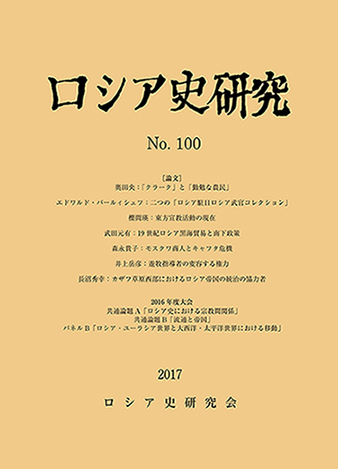100 巻
選択された号の論文の22件中1~22を表示しています
- |<
- <
- 1
- >
- >|
-
原稿種別: 付録
2017 年 100 巻 p. App1
発行日: 2017/12/15
公開日: 2024/03/19
PDF形式でダウンロード (78K) -
原稿種別: 付録
2017 年 100 巻 p. App2-App3
発行日: 2017/12/15
公開日: 2024/03/19
PDF形式でダウンロード (565K)
論文
-
原稿種別: 論文
2017 年 100 巻 p. 3-28
発行日: 2017/12/15
公開日: 2024/03/19
PDF形式でダウンロード (1128K) -
原稿種別: 論文
2017 年 100 巻 p. 29-53
発行日: 2017/12/15
公開日: 2024/03/19
PDF形式でダウンロード (1400K)
二〇一六年度ロシア史研究会大会
-
2017 年 100 巻 p. 54-56
発行日: 2017/12/15
公開日: 2024/03/19
PDF形式でダウンロード (803K) -
2017 年 100 巻 p. 56-60
発行日: 2017/12/15
公開日: 2024/03/19
PDF形式でダウンロード (869K) -
2017 年 100 巻 p. 61-63
発行日: 2017/12/15
公開日: 2024/03/19
PDF形式でダウンロード (865K) -
2017 年 100 巻 p. 63-65
発行日: 2017/12/15
公開日: 2024/03/19
PDF形式でダウンロード (839K)
論文
-
原稿種別: 論文
2017 年 100 巻 p. 66-93
発行日: 2017/12/15
公開日: 2024/03/19
PDF形式でダウンロード (1115K) -
原稿種別: 論文
2017 年 100 巻 p. 94-118
発行日: 2017/12/15
公開日: 2024/03/19
PDF形式でダウンロード (1525K) -
原稿種別: 論文
2017 年 100 巻 p. 119-144
発行日: 2017/12/15
公開日: 2024/03/19
PDF形式でダウンロード (1729K) -
原稿種別: 論文
2017 年 100 巻 p. 145-165
発行日: 2017/12/15
公開日: 2024/03/19
PDF形式でダウンロード (1138K) -
原稿種別: 論文
2017 年 100 巻 p. 166-190
発行日: 2017/12/15
公開日: 2024/03/19
PDF形式でダウンロード (1051K)
書評
-
原稿種別: 書評
2017 年 100 巻 p. 191-198
発行日: 2017/12/15
公開日: 2024/03/19
PDF形式でダウンロード (1117K) -
原稿種別: 書評
2017 年 100 巻 p. 198-204
発行日: 2017/12/15
公開日: 2024/03/19
PDF形式でダウンロード (1079K) -
原稿種別: 書評
2017 年 100 巻 p. 204-209
発行日: 2017/12/15
公開日: 2024/03/19
PDF形式でダウンロード (1141K) -
原稿種別: 書評
2017 年 100 巻 p. 209-215
発行日: 2017/12/15
公開日: 2024/03/19
PDF形式でダウンロード (1141K) -
原稿種別: 書評
2017 年 100 巻 p. 215-222
発行日: 2017/12/15
公開日: 2024/03/19
PDF形式でダウンロード (1155K)
新刊紹介
-
原稿種別: 新刊紹介
2017 年 100 巻 p. 223
発行日: 2017/12/15
公開日: 2024/03/19
PDF形式でダウンロード (581K)
記事目録
-
原稿種別: 付録
2017 年 100 巻 p. 224-228
発行日: 2017/12/15
公開日: 2024/03/19
PDF形式でダウンロード (848K)
編集後記等
-
原稿種別: 付録
2017 年 100 巻 p. 229
発行日: 2017/12/15
公開日: 2024/03/19
PDF形式でダウンロード (695K) -
原稿種別: 付録
2017 年 100 巻 p. 230-233
発行日: 2017/12/15
公開日: 2024/03/19
PDF形式でダウンロード (484K)
- |<
- <
- 1
- >
- >|
